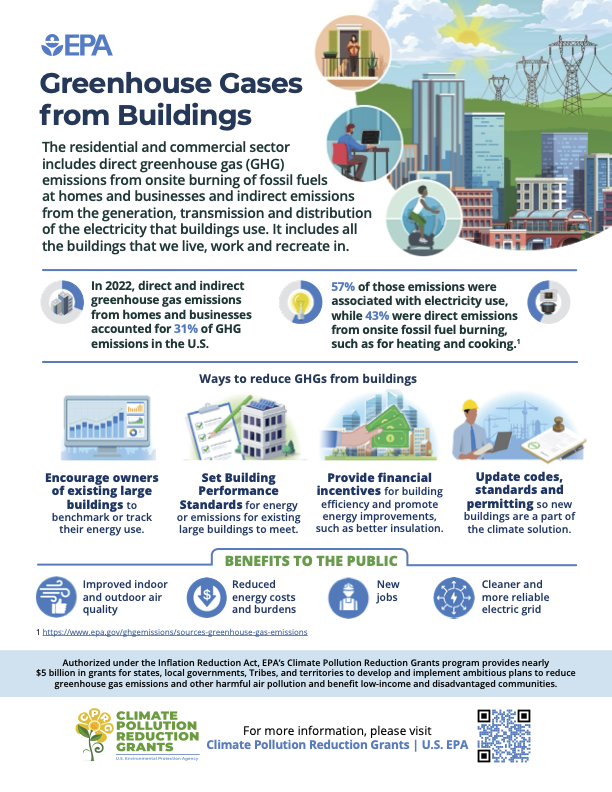CPRG - Buildings Sector Infographic

The residential and commercial sector includes direct greenhouse gas (GHG) emissions from onsite burning of fossil fuels at homes and businesses and indirect emissions from the generation, transmission and distribution of the electricity that buildings use. It includes all the buildings that we live, work and recreate in.
- In 2022, direct and indirect greenhouse gas emissions from homes and businesses accounted for 31% of GHG emissions in the U.S.
- 57% of those emissions were associated with electricity use, while 43% were direct emissions from onsite fossil fuel burning, such as for heating and cooking.

View or download the English version CPRG Sector Infographic - Buildings (pdf) or the Gases de efecto invernadero de los edificios (pdf)
Ways to Reduce GHGs from the Buildings Sector
Below are some examples of ways states, local governments, Tribes and territories can reduce GHG emissions from the Buildings sector:
- Encourage owners of existing large buildings to benchmark or track their energy use.
- Set Building Performance Standards for energy or emissions for existing large buildings to meet.
- Provide financial incentives for building efficiency and promote energy improvements, such as better insulation.
- Update codes, standards and permitting so new buildings are a part of the climate solution.
Benefits to the Public
- Improved indoor and outdoor air quality
- Reduced energy costs and burdens
- New jobs
- Cleaner and more reliable electrical grid
About CPRG
Authorized under the Inflation Reduction Act, EPA’s Climate Pollution Reduction Grants program provides nearly $5 billion in grants for states, local governments, Tribes, and territories to develop and implement ambitious plans to reduce greenhouse gas emissions and other harmful air pollution and benefit low income and disadvantaged communities.
More Information
- Refer to EPA's Sources of Greenhouse Gas Emissions and The Multiple Benefits of Energy Efficiency and Renewable Energy for more information.
- Learn about ways states, local governments, Tribes and territories can reduce greenhouse gas emissions in other sectors (en español: Programa de Subvenciones para la Reducción de la Contaminación Climática).
